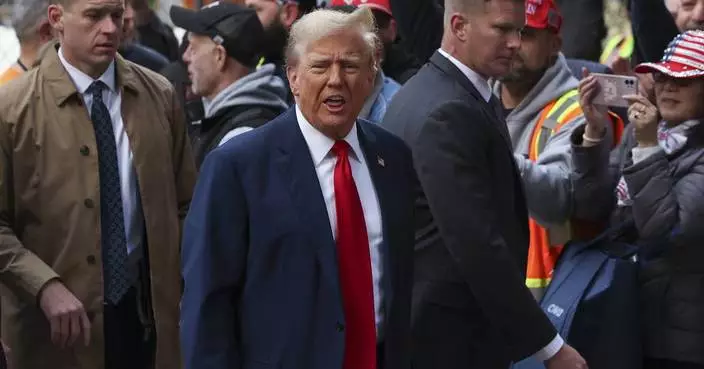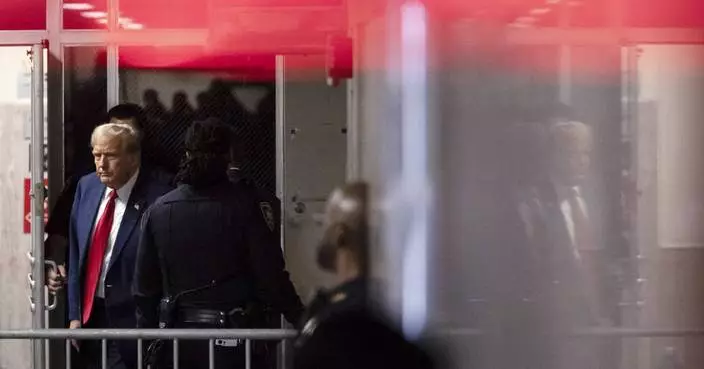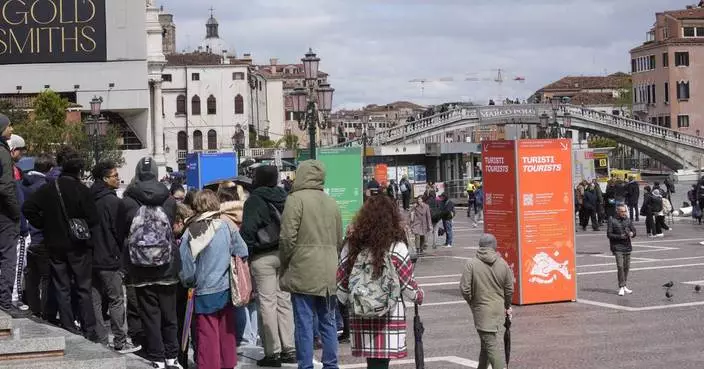Donald Trump and Vladimir Putin may have reached several historic agreements at their summit in Finland this week. Or, they may not have. It depends on who you talk to. Three days later no one was quite sure.
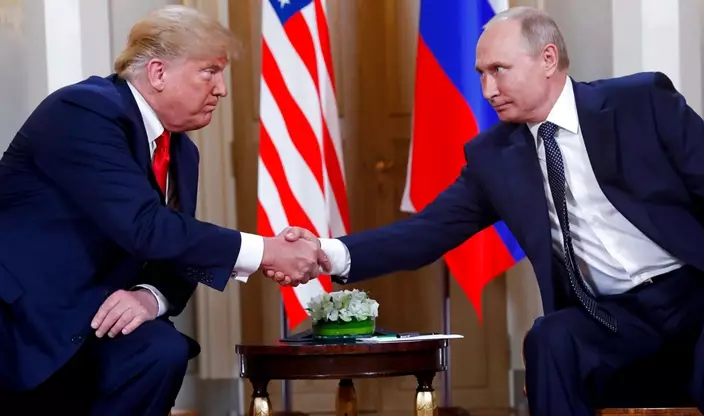
In this July 16, 2018, photo, U.S. President Donald Trump, left, and Russian President Vladimir Putin, right, shake hands at the beginning of a meeting at the Presidential Palace in Helsinki, Finland. Trump and Putin may have reached several historic agreements at their summit in Finland this week. Or, they may not have. Three days later no one is quite sure. With no details emerging from the leaders’ one-on-one discussion on Monday other than the vague outline they offered themselves, officials, lawmakers and the public in the United States in particular are wondering what, if anything, was actually agreed to. (AP Photo/Pablo Martinez Monsivais)
With no details emerging from the leaders' one-on-one discussion on Monday — other than the vague outline they offered themselves — officials, lawmakers and citizens in the U.S. in particular are wondering what, if anything, was actually agreed to. Both Trump and Putin have declared the meeting a grand success that is soon to reap great rewards in numerous geopolitical realms, yet even the most complete accounting of the talks — one provided by Putin — suggests that any outcomes are far from certain.
And, the fact that a high-profile, high-stakes summit between the commanders in chief of the world's two biggest nuclear powers could be held without a solid achievement or failure to point to has flummoxed many.
In the U.S., frustration with the lack of information has raised already heightened suspicions of Trump. Democratic lawmakers have pushed to subpoena the notes of the State Department interpreter who translated for Trump or compel her to testify. Republicans have blocked the move. Officials said Thursday the White House and State Department were also likely to fight such a move as a breach of executive authority, making the appearance of the notes unlikely until they are published in a historical record decades from now.
So for now, everyone but Trump and Putin and perhaps a handful of their close confidants are in the dark. Even Trump's own intelligence chief, Dan Coats, said Thursday, "I don't know what happened in that meeting."
"It is utterly amazing, utterly amazing, that no one knows what was said," Chuck Schumer, the top-ranking Democrat in the Senate, said. "This is a democracy. If your president makes agreements with one of our leading — if not our leading — adversary, his Cabinet has to know about it and so do the American people."
Typically, a summit, especially one between two major powers, will occur after weeks and months of meticulous planning at lower levels with an eye toward producing demonstrable results. Agenda topics, talking points, desired outcomes and even major portions of significant agreements are normally negotiated in advance so the relevant agencies of both countries are aware of any potential policy changes. In some cases, the actual summit meeting and leaders' signatures on a piece of paper or a joint communique are mere formalities as the hard work has already been done by subordinates.
Those conventions have been upended by Trump's buccaneering approach to affairs of state — the kind of approach he thinks worked in his landmark summit with North Korean leader Kim Jong Un last month. But this time there was no joint statement to formalize the outcome of the talks — just a meandering, 45-minute press conference where Trump stoked controversy by appearing to side with Putin over U.S. intelligence agencies' assessment that Russia meddled in the 2016 election.
Russia's ambassador to the U.S., Anatoly Antonov, expressed hope Thursday that "the verbal agreements between Putin and Trump will be fulfilled" — though the substance of any such understandings remain murky, not least because the main business was conducted in the two hours of discussions between the two leaders with only translators joining them.
On Thursday, the Trump administration poured cold water on at least one proposal from Putin: that Russia be allowed to interview Americans the Kremlin accused of crimes — the quid pro quo for allowing U.S. investigators to interrogate Russian intelligence officials recently indicted in the U.S. for alleged election interference.
"That's not going to happen," Secretary of State Mike Pompeo said of the Russian proposal in an interview with the Christian Broadcasting Network.
Still, from Putin's perspective, the summit put Moscow and Washington on "the path to positive change." In recent days he has spoken of finding broad consensus with Trump on ensuring security along Syria's border with Israel and on arms control issues. Russia's defense and foreign ministries, meanwhile, have both said they are ready to start putting those agreements into action.
Trump himself has also put a positive spin on the summit. He says a second meeting with Putin will usher in the implementation of the laundry list of items they discussed in Helsinki. Those, he said in a tweet, include terrorism, security for Israel, nuclear proliferation, cyberattacks, trade, Ukraine, Middle East peace and North Korea. "There are many answers, some easy and some hard, to these problems ... but they can ALL be solved!" he said.
Pressed for details, however, the White House could not provide any.
Press secretary Sarah Huckabee Sanders mentioned Syria, Iran, Israel, arms control, Russia's annexation of Crimea from Ukraine and its meddling in 2016 U.S. election as having been discussed. But turning those issues from topics of discussion into action apparently remains a work in progress.
"This is the beginning of the dialogue with Russia and our administration and theirs and we're going to continue working through those things," she told reporters at the White House on Wednesday.
Just minutes later, the State Department offered its own take on the Helsinki meeting, saying that no agreements were reached; just general proposals on matters mainly related to economic and strategic cooperation.
Spokeswoman Heather Nauert said three proposals were made: one for a high-level working group with U.S. and Russian business leaders to be convened; another for the creation of an "expert council" of academics, current and former diplomats and military officials from both countries to look broadly at U.S.-Russia relations, and a third one for the U.S. and Russian national security councils to hold a series of follow-on meetings.
"You know, these are certainly all modest proposals," she said. "The president had said going into this that we wouldn't solve all the world's problems in one meeting, in one conversation with the Russian government but we think it's a pretty good place to start."
At the Pentagon, officials were still waiting to see if their marching orders in Syria would change as a result of the summit.
The commander of U.S. forces in the Middle East said Thursday he had not received new guidance from the Pentagon on cooperating with Russia in Syria.
"We have received no further direction than we've currently been operating under," Gen. Joseph Votel said in a video-teleconference from his headquarters in Tampa, Florida. He said he's taking a "steady-as-she-goes" approach in Syria in the absence of new instructions.
NEW YORK (AP) — Rooting for Donald Trump to fail has rarely been this profitable.
Just ask a hardy band of mostly amateur Wall Street investors who have collectively made tens of millions of dollars over the past month by betting that the stock price of his social media business — Truth Social — will keep dropping despite massive buying by Trump loyalists and wild swings that often mirror the candidate’s latest polls, court trials and outbursts on Trump Social itself.
Several of these investors interviewed by The Associated Press say their bearish gambles using “put” options and other trading tools are driven less by their personal feelings about the former president (most don’t like him) than their faith in the woeful underlying financials of a company that made less money last year than the average Wendy’s hamburger franchise.
“This company makes no money. ... It makes no sense," said Boise, Idaho, ad executive Elle Stange, who estimates she’s made $1,300 betting against Trump Media & Technology stock. “He's not as great a businessman as he thinks. A lot of his businesses go belly up, quickly.”
Says Seattle IT security specialist Jeff Cheung, “This is guaranteed to go to zero.”
As of Friday morning, a month since Trump Media’s initial public offering sent its stock to $66.22, it has plunged to $38.49. An AP analysis of data from research firms FactSet and S3 Partners shows that investors using puts and “short selling” have paper profits so far of at least $200 million, not including the costs of puts, which vary from trade to trade.
Still, amateur traders, mostly risking no more than a few thousand dollars each, say the stock is too volatile to declare victory yet. So they are cashing in a bit now, letting other bets ride and stealing a glance at the latest stock movements in the office cubicle, at the kitchen table or even on the toilet.
There have been plenty of scary moments, including last week when DJT, the ex-president’s initials and stock ticker, jumped nearly 40% in two days.
“I don’t know which direction the stock is going,” says Schenectady, N.Y., day trader Richard Persaud while checking his iPhone amid the surge. “It’s so unbelievably overvalued.”
Many who spoke to the AP say knowing their bets have helped slash the value of Trump’s 65% stake in half is an added political benefit. If some of their predictions are right, they may able to someday push it to zero, making it impossible for him to tap it to pay his hefty legal bills or finance his GOP presidential campaign.
They have a long way to go. Trump’s stake is still worth $4 billion.
Normally, investors betting a stock will fall, especially a gutsy breed of hedge fund traders called “short sellers,” will do plenty of homework. They’ll pore over financial statements, develop expertise in an industry, talk to competitors, and even turn to “forensic accountants” to find hidden weaknesses in the books.
No need in Trump Media’s case. It’s all there in the Sarasota, Florida-based company's 100-page financial report: A firehose of losses, $58 million last year, on minuscule revenue of $4 million from advertising and other sources.
The losses are so big, as Trump Media’s auditor wrote in the report, they “raise substantial doubt about its ability to continue as a going concern.”
A short seller’s dream? Or is it a nightmare?
Amateur trader Manny Marotta has two computer screens at home, one for work, the other showing DJT stock's movements where he can gauge how much he’s up or down.
It wasn’t looking so good earlier this week.
The legal writer from suburban Cleveland had been up about $4,000 on “put” options purchased over the past few weeks. But the screen that morning was showing investors, presumably rich ones, buying large volumes of DJT shares, pushing up the stock once again.
“My options are worth less with every passing minute,” says Marotta, adding about DJT: “It’s being manipulated. It’s insane.”
Waiting for the stock to drop is especially painful to “short sellers,” who pay a fee to borrow shares owned by others. The idea is to quickly sell them on a hunch then they will be able to buy the same number of them later for much cheaper before having to return them to the lender. That allows short sellers to pocket the difference, minus the fee, which is usually nominal.
In DJT’s case, the fee is anything but nominal.
It was costing 565% a year at one point earlier this month, meaning short sellers had only two months before any possible profits would be eaten up in fees, even if the stock went to zero. It’s a rate so off the charts, that only three other stocks in recent memory have exceeded it, according to data from Boston University’s Karl Diether and Wharton’s Itamar Drechsler, who have studied short selling back two decades.
Add in massive buying by Trump supporters who see it as a way to support their candidate, and losses could multiply fast.
“It’s scary,” says Drechsler, who likens buyers of Trump’s stock to unwavering sports fans. “It is everything that you hope that the stock market is not.”
Trump Media spokeswoman Shannon Devine said the company is in a “strong financial position” with $200 million in cash and no debt, and said the AP was “selecting admitted Trump antagonists.”
Another danger to the stock is a “short squeeze.” If the price rises sharply, it could set off a rush by short sellers who fear they’ve bet wrongly to return their borrowed shares right away and limit their losses. And so they start buying shares to replace the ones they borrowed and sold, and that very buying tends to work against them, sending the price higher, which in turn scares other short sellers, who then also buy, setting off a vicious cycle of price hikes.
“If DJT starts rallying, you’re going to see the mother of all squeezes,” says S3 Partners short-selling expert Ihor Dusaniwsky, who spent three decades at Morgan Stanley helping investors borrow shares. “This is not for the faint of heart.”
And if that wasn’t enough, there is a final oddball feature of DJT stock that could trigger an explosion in prices, up or down.
“Lock up” agreements prohibit Trump and other DJT executives from selling their shares until September. That leaves the float, or the number of shares that can be traded each day by others, at a dangerously tiny 29% of total shares that will someday flood the market. That means a big purchase or sale on any day that would barely move a typical stock can send DJT flying or crashing.
The float is smaller than that of most other notoriously volatile stocks. At their smallest levels, AMC, GameStock and Shake Shack each had more than double the float.
Seattle trader Cheung sees DJT’s freak characteristics as a reason to bet against the stock, not shy away. When the lock-up period ends, he predicts, the ex-president will indeed sell his shares, spooking the market and sending the price down sharply. And even if he doesn’t, other insiders whose lock-ups expire will fear he will do so and will move fast to get a good price before it falls.
“The first one to sell out is going make to most, ” Cheung says. “Everyone is going to sell.”
Still, he doesn’t want to lose money in the interim, so Cheung is offsetting some of his “put” bets with the purchase of “calls.” The latter are also derivatives, but they do the opposite, paying off when the stock rises. Cheung hopes that whichever makes money, the puts or the calls, he will make enough with one to more than make up for the loss of the other.
If all of this seems too complicated, there is a far simpler way to make money betting against Trump.
Offshore, casino-style betting sites are taking wagers on the 2024 election, and some have even made President Joe Biden the favorite.
Contact AP’s global investigative team at Investigative@ap.org or https://www.ap.org/tips/

Former President Donald Trump sits in a courtroom in Manhattan criminal court, before the start of his trial on Thursday, April 25, 2024, in New York. (Mark Peterson/Pool Photo via AP)
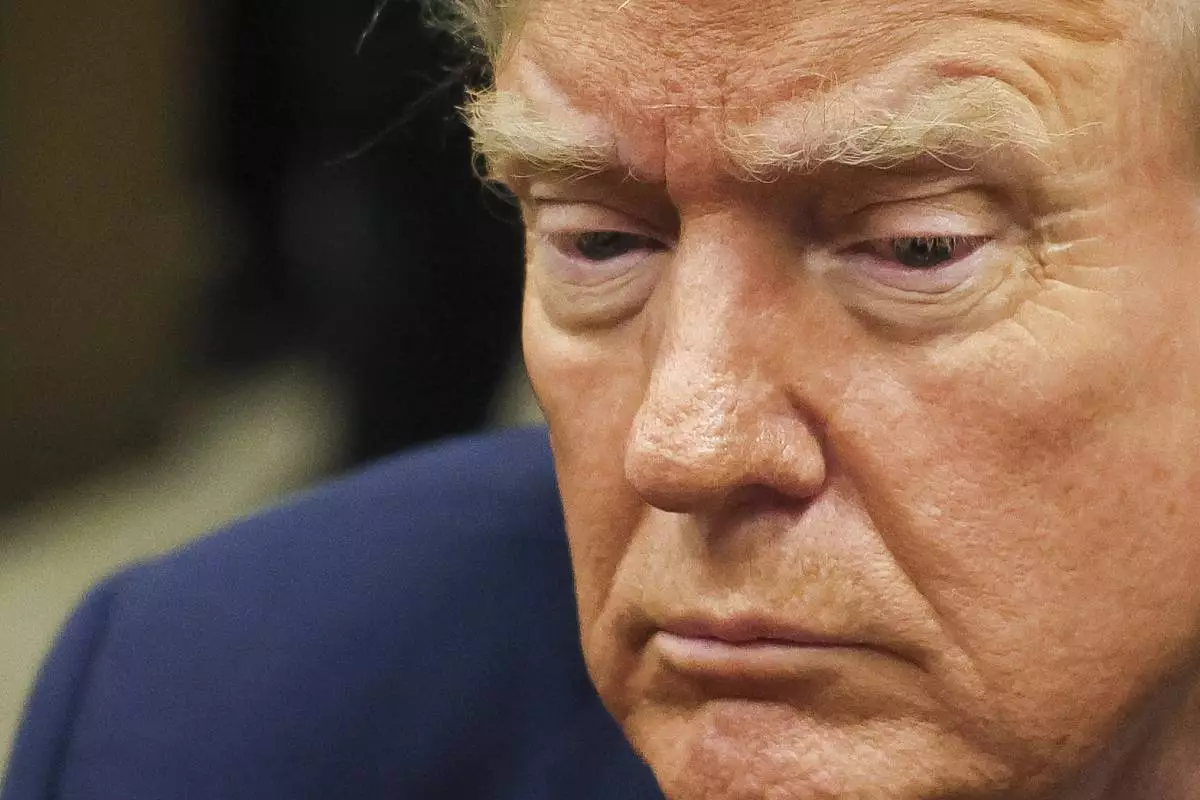
Republican presidential candidate and former President Donald Trump sits in Manhattan state court in New York, Monday, April 23, 2024. (Brendan McDermid/Pool Photo via AP)
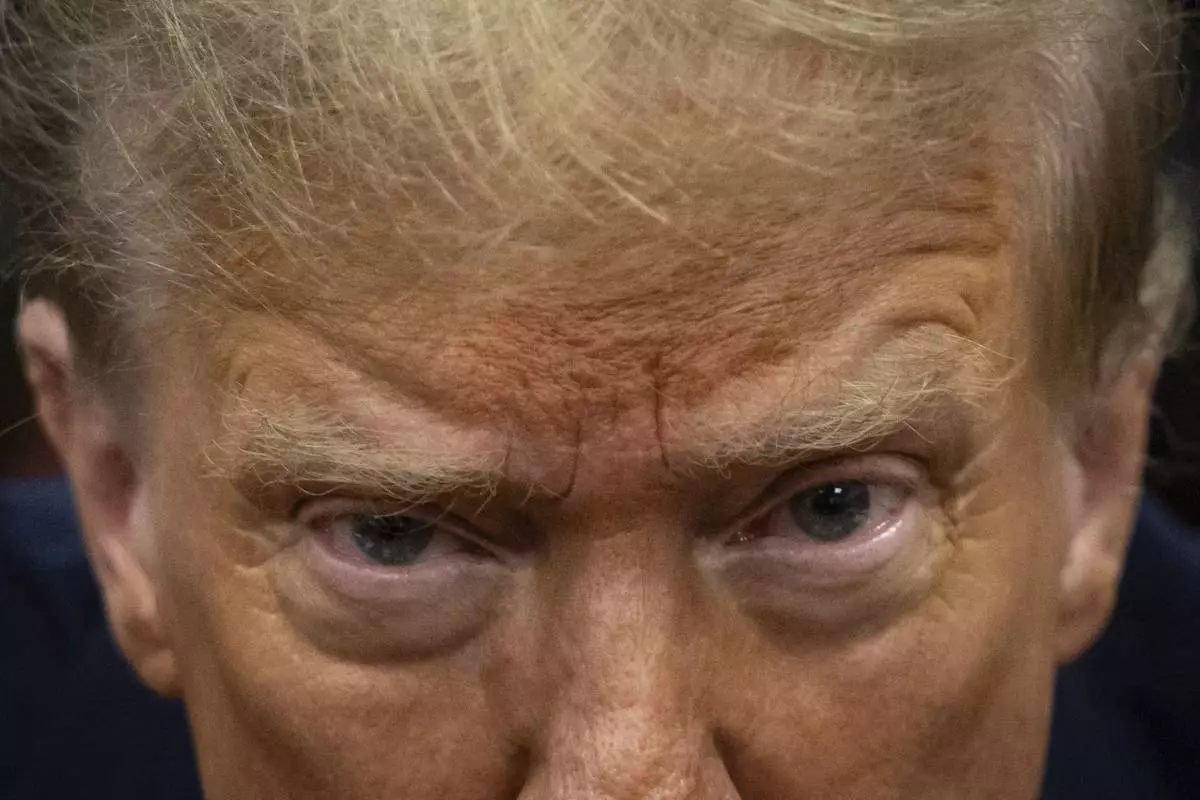
Former President Donald Trump waits for the start of proceedings in Manhattan criminal court, Tuesday, April 23, 2024, in New York. (AP Photo/Yuki Iwamura, Pool)








